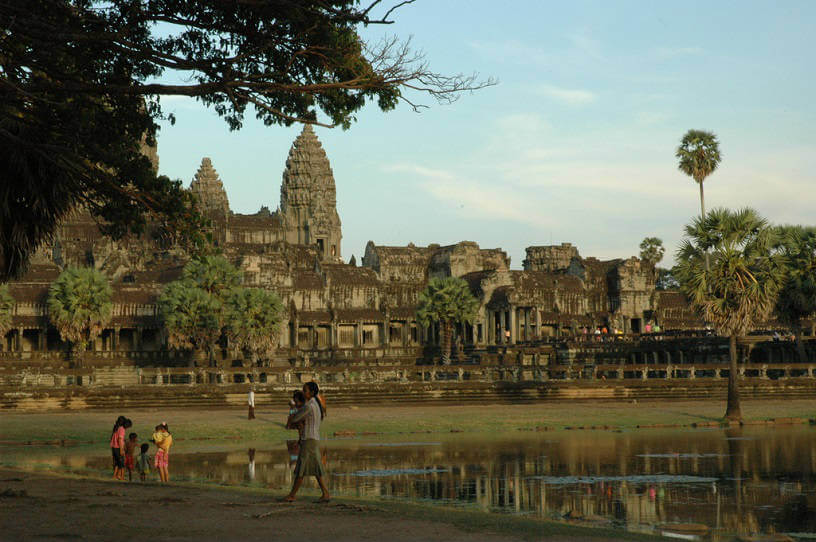A Visit to Angkor Wat

Every time Cambodia is brought up, it seems like Angkor Wat follows in the next sentence. It is perhaps the most famous of attractions in all of Cambodia, and the history surrounding it is enough to catch anyone’s attention and imagine. When the name of Angkor Wat is translated into English it comes to mean “Temple City” and that’s an accurate description. After all Angkor Wat is more than just one building that has become famous. Angkor Wat is a collection of buildings, temples, pagodas, and more that are all open for the public to explore. It’s no wonder Angkor Wat has become the focal point of Cambodia’s tourist industry.
History
This temple has always been famous. During a time when almost all other Hindu temples were being dedicated to Shiva, Angkor Wat was built and dedicated to Vishnu. This break from tradition was enough to earn the temple extra attention, but who built it spawned even more notoriety.
Khmer King Suryavarman built this temple as his state temple where he would spend hours in prayer and reflection. Later, after his death, Angkor Wat became his mausoleum. After he passed away, the purpose and function of the temple gradually shifted—mostly through the 13th century—to become a Theravada Buddhist temple and has remained so ever since.
Unlike other temples in Cambodia, Angkor Wat has also had the great luck to be taken care of. Instead of resting in ruins, the temple has been cared for throughout its lifetime. In the 20th century, there was a restoration effort that got underway, and while this effort was interrupted by the reign of the Khmer Rouge during the civil war, the temple emerged unscathed and as beautiful as ever.
Today, the temple is a powerful symbol for Cambodia and one of the most popular tourist spots in the world. When visiting Angkor Wat it will take some planning to ensure you aren’t standing in the dead heat of the day with tons of people swarming around you.
Architecture
Angkor Wat was built in the typical “temple mountain” form but, unlike most other Khmer temples, Angkor Wat is positioned towards the West rather than the East. This orientation supports the theory that this temple was built to be a funerary temple. The theory gets even stronger when you take a closer look at the style of bas reliefs present.
The temple is a prime example of the classical style of Khmer architecture. The Angkor Wat style, unsurprisingly named after this temple, includes characteristics such as the ogival, the lotus bud-shaped towers, and conservative decorative elements.
Best Time to Visit
Angkor Wat is one of the most visited tourist destinations in the world and a huge benefit to the local economy. As a result of this popularity, a spur of the moment visit to Angkor Wat at the wrong time could leave you stuck in the heat without a plan or an idea of how to tackle the grand temple. At the peak times, you’ll be faced with crowds of people and find yourself bumper to bumper with hundreds of tuk tuks shuffling passengers from the temple back to the city.
If you have a few extra dollars to spend, try hiring an expert tour guide who can take you at a time that will be comfortable but will still give you an excellent view of the temple grounds. Many of the tour companies will create a customized experience so that you can not only visit Angkor Wat, but all of the other sites in Angkor that you want to see.
If you would prefer to go out on your own, you should head out as early as possible to get there before the tour groups start. Be aware that you may still encounter some people out and about as some temples are popular spots to sit and watch the sun come up. You can also go later in the day, especially if you pack your flashlight. This will let the crowds thin out. Once again though, many of the temples with the best panoramic views may still be busy with people watching the sun go down.
Pack your best walking shoes, check your flashlight’s batteries, and get ready to experience one of the most beautiful and surreal temples in all of Southeast Asia. Keep your memories safe by getting covered and staying protected from any unexpected problems you come across.
Image courtesy of Flickr user Steve Cornish.
Planning a trip?
Discover Our COVID-19 Cover
To find out what our current* benefits do – and don’t – cover, please read:
Plus, for helpful destination-based COVID-19 information, don't forget to check the COVID-19 Travel Risk Tool before and during travel.
*The cover information contained on the above pages refers to Cover-More policies sold on or after 26 June 2023. For cover information on policies sold prior to this date, please read the relevant PDS.